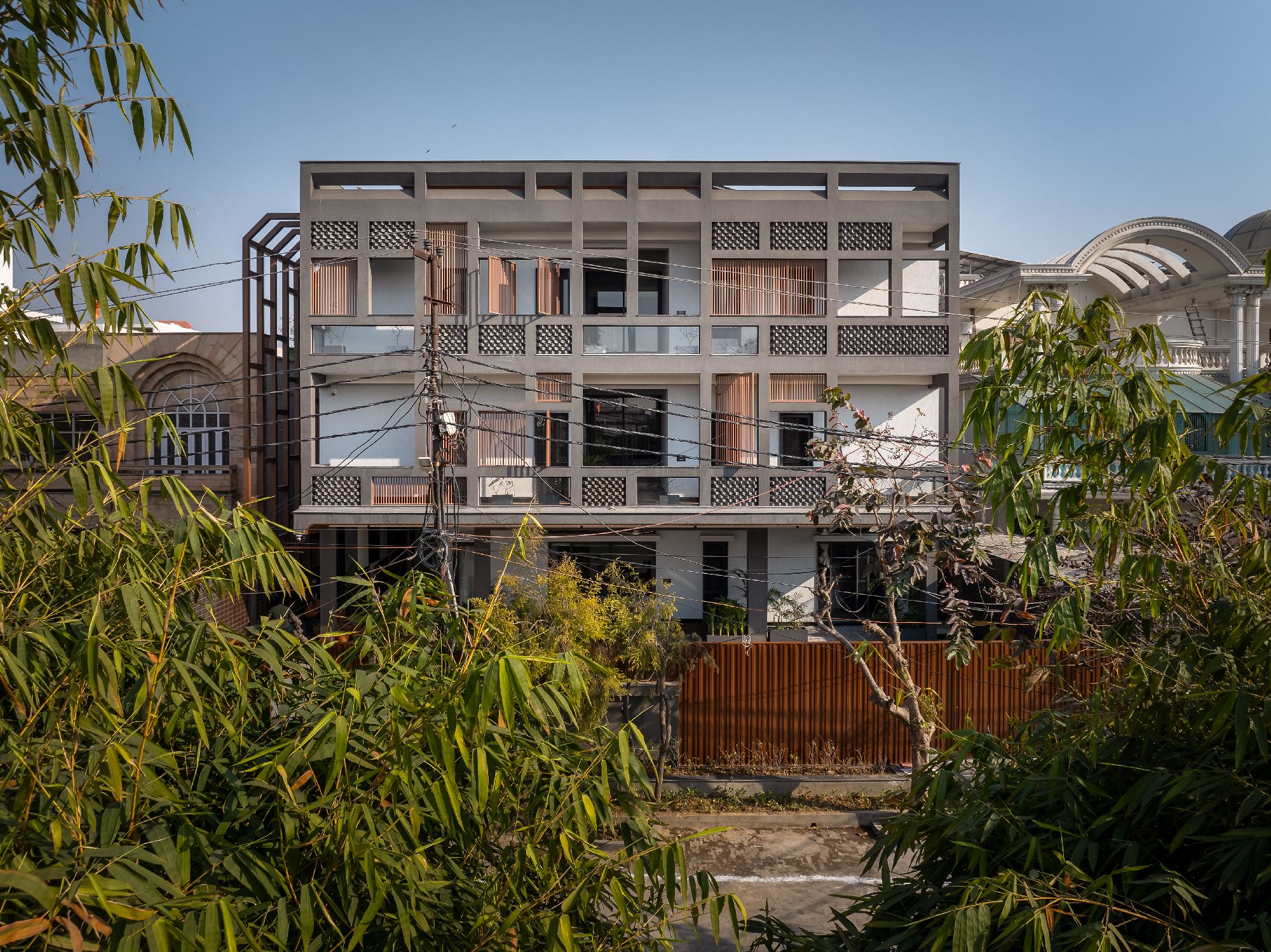SIAN Architects created an innovative solution to overcome heavy pollution in the downtown. This smart home is located in amidst a city with noisy terminals and mills. In addition, the area is also a severe monkey menace.
The architect designed a house that functions like a coconut. Coconut has a hard outer skin but has softness on the inside. The facade of the home has an industrial impression. The grid motif in the building’s skin and layout allows sunlight and fresh air to permeate every corner of the house, effectively moderating this metaphorical ‘bastion’.

This smart home is located in amidst a city with noisy terminals and mills in Hapur, Uttar Pradesh, India. In addition, in the area is also a severe monkey menace.
The house has porous massing that underpins the whole layout and facade, it presents an intriguing interplay of volumes and textures— defining its own vocabulary of built and unbuilt spaces.
At first glance, the building’s facade is distinguished by its rustic appearance. The plot’s entrance is flanked by towering 40-foot metal columns; while beige-coloured fly-ash bricks, set in dark raw concrete, illustrate the facade. Upon entering, the ambience transitions from rugged exteriors to refined, expansive interiors. This area features a plush bench, next to a planter, with the plant stems touching the ceiling. A simple but striking installation of mirrors takes centre stage here, adding to the overall grandeur and drama of light and shadows in the space.


Designed for a multi-general family of three brothers, The Urban Oasis addresses diverse family needs. The three levels of the building house kitchens and expansive living and dining areas, functioning as individual units as needed. There are eleven bedrooms accommodated on the ground, first, and second floors, while also making room for guests.
Guided by Vastu principles and driven by functionality, the layout is punctured with a central courtyard, light courts, and indoor gardens on the upper floors. The central courtyard forms the home’s nucleus, offering a seamless visual connection to surrounding common areas. On the upper floors, the private spaces open up to shared indoor gardens, blurring the boundaries between indoors and outdoors. Adorned with arched glazing, and customised bumper bricks, these courtyards act as vital hubs fostering connections and family living.
(Vastu Shastra is an ancient Indian architectural science that focuses on aligning buildings and spaces with natural forces to promote well-being, prosperity, and positive energy. It involves principles related to orientation, layout, and design to create harmonious environments).


In addition to standard living and sleeping spaces, the building boasts of an impressive view pavilion overlooking a water body– working as the perfect informal lounging space for a family of 11. The water body, fuelled by an ecologically sustainable source, is strategically designed to allow the west-to-east breeze to flow through the house, cooling the building via the courtyard and indoor gardens. Additionally, native evergreen plants are planted in the landscaped area, which need minimal maintenance and water, thereby preserving the natural ecosystem.
Spatially, the design employs minimal walls and barriers, promoting visual continuity in deep, elongated spaces that transition across multiple scales. Large glass panels throughout the house allow natural light to flood the space, creating an airy and bright ambience while blending indoor and outdoor spaces. The interior palette follows a minimalist design narrative, with textures as the key element, channelling a pared-back aesthetic. Its organic ambience is perpetuated by monotones of grey, acting as a cooling antidote to the warm and earthy browns. The flooring features lustrous Indian marble with a unique combination of bricks, taking forward the narrative of rugged yet refined. The stone layout follows a pattern that mirrors the facade design– adding sophistication while maintaining a cool temperature, making it comfortable for occupants year-round in the harsh North Indian climate.

The project maximises its impact by creating an environment that supports the local economy by featuring local craftsmanship. With most of the furniture crafted onsite, rugs intricately woven by local artisans, wall art conceived and executed onsite, bespoke tiles and wall lights enhancing its allure, this home revels in authentic detailing done regionally. A testament to collaborative thinking and hyper-local craftsmanship, the architects recognise the value of diverse perspectives to cultivate innovative solutions and enrich the creative process. The soft furnishings are sourced from the client’s cotton enterprise, while the bells in the prayer rooms are hand-painted by resident women, imbuing the space with familiarity and warmth.

In its essence, this residence transcends conventional urban living, offering a transformative experience within an industrial environment. The fusion of rugged and refined comes together to create a calm, well-lit haven— a sanctuary that epitomises contemporary living amidst the clamour of industrial cities.
See more images in the gallery below
Name of Project: The Urban Oasis
Location: Hapur, Uttar Pradesh, India
Architect: SIAN Architects
Principal Architects: Deepanshu Arneja and Surbhi Singhal
Built-Up Area (sq ft): 15000 sq. ft.
Completion Date: March 2024
Photographer: Ekansh Goel
About SIAN Architects
SIAN Architects is a Delhi-based design practice that aspires to create immersive architectural experiences through art and engineering. Founded in 2018 by architects Surbhi Singhal and Deepanshu Arneja, the firm emerged from a shared vision to establish a practice rooted in the power of collaboration, with an authentic design ethos. SIAN’s unique approach involves nurturing each project in a dynamic workshop-like environment, that celebrates local craftsmanship and material innovation, fostering a collaborative discourse among clients, team members, consultants, and artisans.
SIAN transcends project constraints or trends by continually striving to create impactful architecture which embraces social, economic and environmental responsibility. With over 40 completed projects across India, spanning diverse typologies within the architectural and interior design realm, and 100,000 sq. ft. of spaces currently under construction, the studio works with a hands-on approach, to design holistic spaces effectively.

The firm adopts an experimental approach, constantly pushing the boundaries of design by exploring novel approaches to enrich its designs. Driven by a passion for research and knowledge-sharing, the studio serves as an inclusive and constructive laboratory for new learnings and insights, fostering advancements within the industry. This approach allows SIAN to innovate and integrate cutting-edge techniques and materials, resulting in timeless and sustainable architectural solutions.
The firm’s work has garnered recognition in esteemed national and international publications, including Elle Decor and Goodhomes, among others. SIAN has also clinched victories in various design competitions, underpinning the firm’s commitment to offering inventive solutions to urban challenges like affordable living and product design. For instance, their winning entry in Project Lari: An International Design-build Competition, reinterprets Indian urbanity through a transformable street cart. Such projects enable SIAN to spearhead transformative changes in urban landscapes, pioneering innovative solutions that redefine the way we interact with and inhabit our cities. Adding to their design accolades, SIAN also won a runner-up award at the WADE Asia Awards 2023 in the ‘Best Use of Colour’ category for one of their retail projects.
While each of SIAN’s projects possesses a distinctive identity shaped by its context and approach, they are united by a dedication to thoughtful design and innovation. From architectural forms and spatial arrangements to interior palettes and selections, the designs exude a cohesive aesthetic that is unmistakably SIAN. Through strategic interventions and thoughtful gestures, SIAN aspires to make a significant impact on the built environment, transforming ordinary spaces into extraordinary experiences that inspire, delight, and endure for generations to come.

